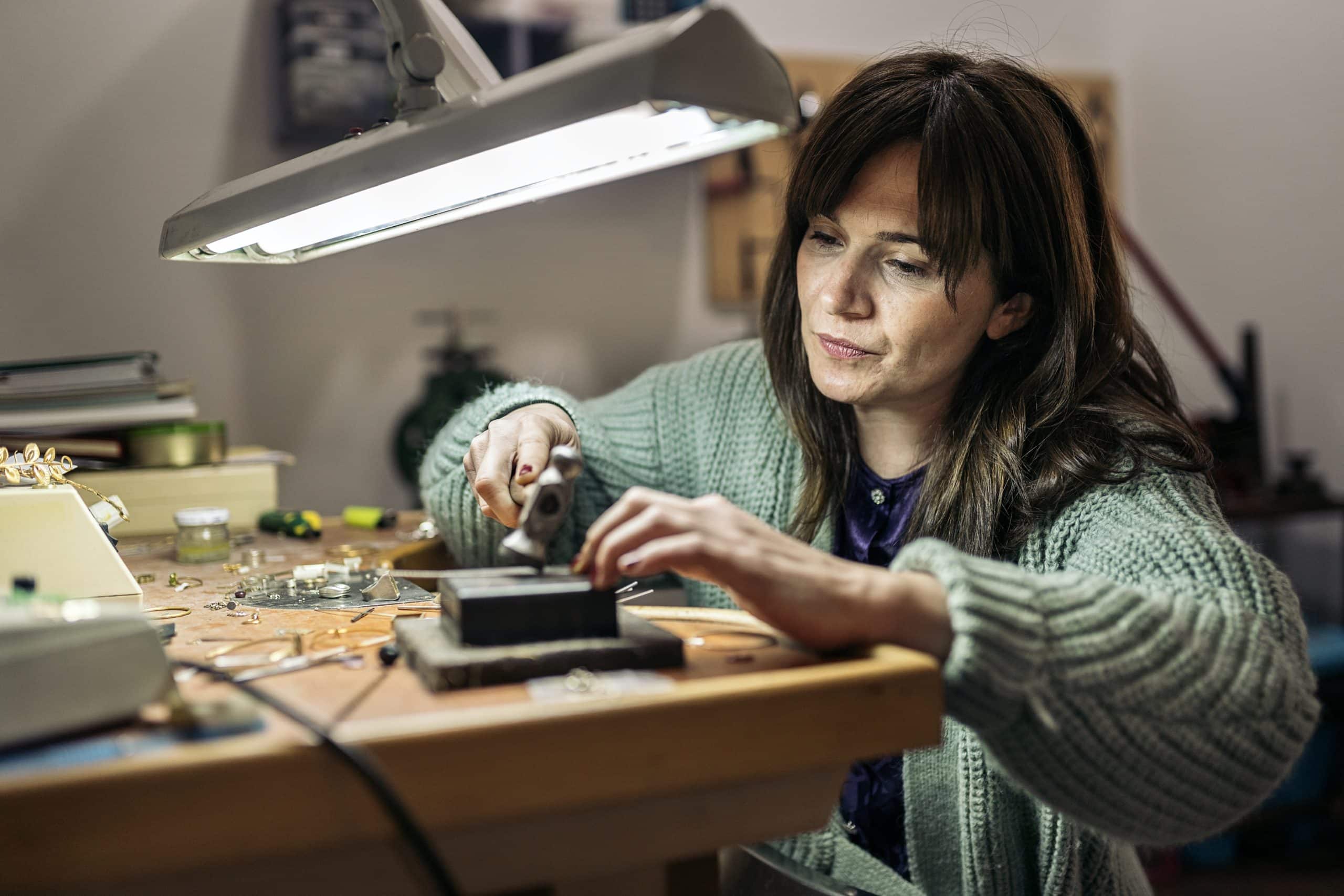What’s the Ideal Setup for a Home Crafting Studio for Jewelry Making?

In today’s digital era, the growth of home-based businesses has been tremendous. Among these, jewelers and artisans who craft intricate jewelry pieces from the comfort of their homes have seen a significant rise. Setting up a home crafting studio for jewelry making isn’t as daunting as it may initially seem. With just a few essential tools, a dedicated workstation, and a well-thought-out arrangement, you can create a space that promotes creativity and efficiency. This article will delve into the essentials you need to set up your home workshop, from the perfect table to the right storage solutions.
Create Your Work Space
First and foremost, you need a dedicated workspace. This does not necessarily mean a separate room. You can set up your studio in a small corner of your living room or your bedroom. The important thing is that this space allows you to concentrate on your work and is free from interruptions.
A lire en complément : How to Design a Multifunctional Mudroom with Space-Saving Features?
Given the intricate nature of jewelry making, adequate lighting is vital. Natural light is ideal and will provide the most accurate color representation. If your workspace lacks natural light, you’ll want to invest in a quality desk lamp. Ensure it provides enough illumination for the detailed work that lies ahead.
Even a small table can serve as an effective workstation. However, make sure it is sturdy and spacious enough to accommodate your tools and materials. A table with a non-slip surface is also a great choice. It ensures your tools don’t slide off while you’re engrossed in your art.
A lire en complément : What Are the Effective Steps for Creating a Home Disaster Preparedness Kit?
Choosing the Right Tools
Once you have arranged your workspace, the next step is to equip it with the right tools. Your toolkit will vary based on what type of jewelry you plan to make. However, some essential tools are universal.
For starters, you’ll need a set of pliers. These come in different shapes and sizes, each serving a specific purpose. Round-nose pliers are used for bending and shaping metal, while chain-nose pliers are great for opening and closing jump rings.
Another essential tool is a jeweler’s saw. This tool will help you cut through metal with precision. You’ll also need a hammer for shaping and hardening your jewelry pieces.
A jeweler’s torch is another valuable addition to your toolkit. It allows you to do intricate soldering work and is especially useful if you plan to work with precious metals.
Organise Your Storage
With so many small components and tools involved in jewelry making, proper storage is crucial. You don’t want to waste time searching for a specific bead or tool when you’re in the midst of creating a masterpiece.
Invest in a storage system that allows you to categorize and label your materials. This could be anything from small plastic containers to a multi-drawer storage unit. Remember, the goal is to keep your workspace uncluttered and your materials easy to find.
In addition to storage for your materials, consider storage solutions for your finished pieces. Velvet-lined drawers or display cases can keep your work free from damage and dust.
Safety Measures in Your Workshop
In the process of making jewelry, you will be dealing with sharp tools, potentially harmful chemicals, and hot metals. Therefore, it’s essential to consider safety measures in your home studio setup.
Always have a first aid kit handy in your workspace. This should include bandages, antiseptic, and burn cream. Keep a fire extinguisher nearby, especially if you plan to do any soldering.
When working with chemicals, ensure you have proper ventilation. A small fan at your workspace is a good idea if you don’t have a window nearby.
Learning and Progressing in Your Jewelry Making Journey
As you set up your home crafting studio, remember that the journey of learning and mastering the art of jewelry making is an ongoing one. There are numerous resources available online and locally.
Attend workshops, join online forums, or watch instructional videos to learn new techniques. You may also want to invest in a few good jewelry making books for reference.
As your skills grow, so will your need for more advanced tools and materials. Be prepared to adapt and upgrade your studio as you progress in your journey.
Whether you’re a seasoned jeweler or just starting out, a well-planned and organized home studio can make a significant difference in your productivity and enjoyment of your craft.
Remember that the setup for your home studio will be unique to you and what you value in your creative space. Experiment, adapt, and find what works best for you. Because in the end, your workspace should be a place where you feel inspired, comfortable, and ready to create beautiful pieces of art.
Mastering Essential Techniques
Once you have your workspace set up and your tools in place, it’s time to dive into the fascinating world of jewelry making. This will involve mastering some essential techniques, such as wire wrapping, setting jewelry, working with metal clay, or creating beaded jewelry.
Wire wrapping is a popular technique used in jewelry making, allowing you to create unique and intricate designs. This method involves twisting and bending wire to create decorative patterns or to secure gemstones and beads. To start with wire wrapping, you’ll need a good quality set of round and chain nose pliers and some practice wire.
Setting jewelry refers to the method of securing a gemstone or other object within a piece of jewelry. There are many different types of settings, including prong, bezel, and channel. Each setting requires precision and understanding of the shape and size of the gemstone, as well as the right tools such as a setting punch and a jeweler’s loupe for detailed inspection.
Working with metal clay is another excellent technique for jewelry making. Metal clay is made up of tiny particles of metal such as silver, gold, or copper, combined with an organic binder and water. When heated, the binder burns away, leaving behind pure metallic jewelry.
Creating beaded jewelry is one of the most versatile and easy-to-learn techniques for beginners. It requires a variety of beads, some stringing material, and tools like crimping pliers and a bead board.
Remember, learning the basics of these techniques will not happen overnight. It requires patience, practice, and a willingness to learn from your mistakes.
Grow Your Studio Home Business
After setting up your jewelry studio at home and learning the basics, it’s time to think about how to grow your business. Your creative space should not only inspire you to create beautiful pieces of jewelry but also serve as a launchpad for your home business.
To grow your home business, you need to establish your brand. This includes creating a logo and a portfolio of your work. Start by crafting pieces that showcase your unique style and skills. These pieces could range from simple beaded jewelry to complex wire-wrapped designs or custom precious metal pieces.
Using your workspace effectively is vital. A spacious work surface, enough storage, and good organization will help maintain your productivity. It’s also crucial to invest in more advanced tools, like a flex shaft for drilling, grinding, and polishing, as your business grows.
Marketing your business online is also vital for growth. Leverage social media platforms and online marketplaces to showcase and sell your products. Use high-quality photos of your jewelry and provide detailed descriptions to attract potential customers.
A regular presence at local craft markets or pop-up shops can further help you connect with customers and build a local following. Collaborating with local businesses or other artisans could also provide valuable networking opportunities and increase your brand’s visibility.
Remember to keep learning and adapting as your business grows. Attend advanced workshops, take online courses, or find a mentor to help you improve your skills and stay updated with the latest trends in jewelry making.
Conclusion
Creating the ideal setup for a home crafting studio for jewelry making may seem daunting initially, but with careful planning and organization, it can be an enjoyable and rewarding process. Whether you’re converting a spare room into a full-fledged studio or starting small in a corner of your living room, it’s essential to create a space that sparks creativity and enhances productivity.
Start by setting up a sturdy work surface and organizing your tools and materials. Invest in the right tools for your jewelry-making needs, and remember to consider safety measures. As you learn the basics of jewelry making and grow your business, be prepared to upgrade your studio and learn new skills.
Remember, your home studio should reflect your personal style and accommodate your way of working. It should be a place where you feel comfortable and inspired. As you embark on this exciting journey of setting up your home jewelry studio, keep in mind that flexibility, organization, and creativity are key to a successful and enjoyable jewelry-making venture.
